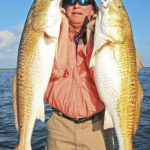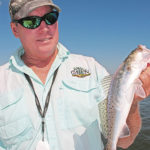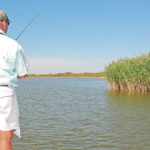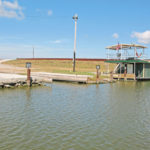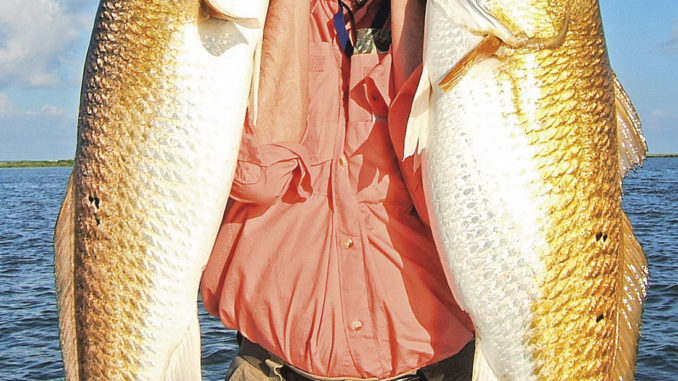
Yellow Cotton Bay still delivers the goods, but it’s just a shadow of its former self.
It was supposed to be a fishing trip, but it turned out to be more like a funeral. I guess I should be used to it by now, having lived and fished in much of the waters along our Southeast Louisiana coast most of my life.
We tend to remember things the way they were, when something planted an indelible memory in our minds. Much like my recent 40-year high school reunion. I stood at the door and watched old school-mates come in, looking for familiar faces, faces I remembered.
But all I saw was a bunch of old people!
Old fishing spots are like that, too. After a few years, they’re virtually unrecognizable due to our dramatic rate of erosion. Here in Louisiana, we’re losing 25 to 30 square miles of coastline. If it were happening in any other state, there would be a national panic and the federal government would assign every capable mind to find an immediate workable solution, and then they’d spend unlimited billions of dollars to fix it.
But its happening in Louisiana, the step-child state.
It doesn’t seem very long ago that Yellow Cotton Bay was a separate, distinguishable body of water from Hospital Bay, and there were marshlands and islands all around it, and it had several very deep holes that filled in with a wide variety of bait every year at this time.
All that bait attracted fish like Black Friday attracts shoppers, and Yellow Cotton Bay became a wintertime hotspot that was nothing short of legendary. On weekends or on any winter holiday, boats could be counted in the hundreds, all anchored and all catching fish.
And you know what happens when a place produces fish: Word gets out, and even more anglers flock in from all over to get in on the easy action. It’s how legends are made, and make no mistake: Yellow Cotton Bay was a legend.
It was known as one of the finest winter trout fishing destinations in the nation. The fact that it was so popular and so consistently productive spurred further development — marinas, motels and cabins, restaurants, gas stations and convenience stores, etc. Note to parish and state governments: Fishing (and hunting) hotspots are their own economic engines, spawning economic growth, bringing in tourism and development dollars and a steady stream of tax revenues.
These prime fishing and hunting habitats must be preserved, and that preservation should take top priority, not just for sportsmen, but for the overall economic health of the region.
Hey, if you’re not going to do it simply because it’s the right thing to do, then do it for the money.
I mention all of this because Yellow Cotton Bay, once the picture of robust health, is dying. I heard about it in the voice of Capt. Ryan Lambert (985-785-9833), who promised to take me fishing there, and I saw it when we pulled out from the Yellow Cotton Marina into the wide-open watery expanse that is Yellow Cotton Bay.
It was unrecognizable.
Had it been so long ago that I fished here? When I first told Lambert that I wanted to do a winter story on Yellow Cotton, he agreed to take me, but I could hear the reluctance in his voice.
“Rusty, it isn’t what it used to be. If you think we’re going to go there and rack ‘em and stack ‘em like we used to, you’re wrong. The Yellow Cotton you remember is long gone.”
He was right.
The entire interior marshland is all gone, the victim of storms and the deadly juggernaut of subsidence and saltwater intrusion. The islands are gone, the grassbeds and ducks are gone, even the deep holes are gone.
Lambert motored his boat in circles over holes that once plunged anywhere from 40 to almost 90 feet. The place where the 25-foot hole used to be is now only 5 feet; the 40-foot hole is 10 to 12 feet; the 60-foot hole is 6 feet and the 89-foot hole is 13 feet at the deepest spot we could find on the depth sounder.
“Just a few years ago, if you came to fish here, you’d have to bring an anchor with a 100 feet of rope. Now I can anchor almost anywhere with my Power Pole,” Lambert said. “The holes were a main attraction in the winter. The bait just piled up in there, and the fish went in after them and stayed there all winter.
“Do you have any idea how many fish came out of this bay? Millions of speckled trout! Millions, and that’s no exaggeration. This spot was so incredibly productive. To look at it now makes we want to cry.”
Lambert says the same storms that accelerate our coastal erosion wiped out the surrounding marshlands and islands, and simply pushed all that marsh dirt into the holes, silting them in. The holes, I learned, were dug out during the developmental stages in the growth of Plaquemines Parish, and the mud was used for road beds and levee construction.
“This area was unbelievable,” he said. “The whole northeast side was a huge grassbed, and a prime habitat for ducks and redfish. There would be so many ducks in here you couldn’t hardly stand the noise. And cypress trees were all over in here. It was beautiful.
“Don’t get me wrong, you can still find some fish in here, trout and reds. But not like before. The glory days are gone.”
Much of the water in the bay had an algae-green tint.
“That algae depletes the oxygen in the water, and the fish will avoid it,” Lambert said.
We tried drifting several different spots where we saw current lines, but we saw no sign of bait in the water, and no bird activity to point us in the right direction.
Lambert moved us over towards the Bay Carrion Crow area, and studied the depth sounder as we motored slowly along.
“I learned long ago that bait will congregate along the ledges of drop-offs, where the water changes depth,” he said. “If you can locate the ledges, that’s where the fish are most likely to be.”
We found a ledge where the depth dropped from 3 to 4 feet down to 6 or 7 feet, and we started our drift. After several casts, Lambert got a strike. He reeled in a keeper-sized trout, and several more followed. I fished a shrimp imitation under a popping cork, and had even better action, and slightly better fish, and after a few more like it, Lambert switched to a cork rig also.
Whenever we bumped into fish, Lambert stuck the Power Pole, and we tried to stay with the action for as long as it lasted. Once the bite stopped, we resumed drifting.
“That’s the way you have to fish this time of year,” he said. “The fish aren’t all stacked up in one spot — they’re scattered — so you have to hit and move, hit and move, until you fill the box. Sometimes I just keep re-drifting the same area, again and again, picking up six or eight trout each time. Do that seven or eight times and over the course of the day you’ll go home with a very nice box of fish.”
Lambert also pointed out what looked like ripples or trenches on the depth sounder, sonar reflections of a wavy bottom.
“Bait will hide in those trenches, and fish will go in there after them,” he said. “That’s the kind of bottom structure you want to look for to find fish. Anglers need to use their depth sounders to locate areas like this; it’ll make them more productive fishermen.”
The Yellow Cotton solution
The Corps of Engineers actually approved a Spanish Pass Diversion project back in 2004, that, according to the corps’ own study, would divert up to 7,000 cubic feet of water per second, along with sediments from Grand Pass, and immediately benefit over 1,500 acres of fresh marsh and open water and create more than 433 acres of marsh over the 20-year project span.
The total cost estimates are calculated to be slightly less than $14 million, a miniscule amount as far as diversion projects and coastal restoration projects go. The project would require the construction of a 1,300 foot diversion channel and containment levees and the construction of a bridge at Tidewater Road, all of which is figured into that cost estimate.
“The project should continue providing benefits 30-40 years after construction because it is an open-channel diversion and has adequate O&M funds budgeted,” the corps document states.
Lambert says the corps and the state are dead-locked over some cost-sharing feature of the project, so it continues to tread water in a bureaucratic state of limbo where it’s been stuck for years. I made half-a-dozen calls to several corps project managers hoping for a status update on the Spanish Pass project, but none returned my calls by press time.
“I don’t want to discourage anyone from fishing Yellow Cotton Bay,” Lambert said, “because this area will still produce fish. It still has some deeper water in spots, 12 to 14 feet deep, that will attract bait and the fish that prey on them. I believe it is still a worthwhile destination.
“You’ll continue to read that Yellow Cotton and Hospital Bay is a winter hotspot, along with Carrion Crow and the Buras Canal. But her glory days are gone — the days when she was a habitat for marsh and aquatic plants and grassbeds and cypress; when ducks were thick in here and a hundred boats were catching trout and reds on any given weekend.
“Unless something is done immediately to try to reverse this erosion, you can blow taps over it all. This erosion is like a cancer in the human body, eating away the very strength and life out of our marshlands.
“I guess my biggest concern is, when they eventually do get this project rolling, it’ll just be so far gone that it’s too little and too late.”
Capt. Ryan Lambert can be reached at (985) 785-9833.
